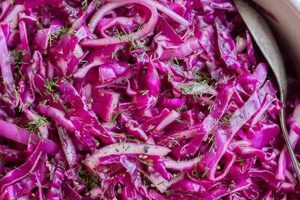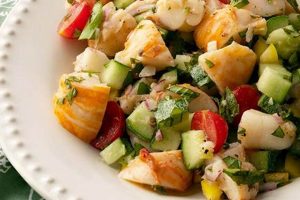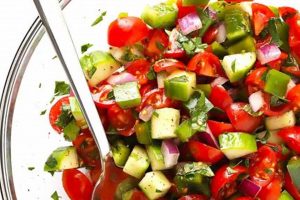Simple and quick-to-prepare salad options suitable for the Thanksgiving holiday often incorporate seasonal ingredients like cranberries, apples, pecans, and winter greens. These dishes can range from classic combinations like a cranberry-walnut salad with a vinaigrette dressing to more innovative pairings, such as roasted butternut squash with kale and pomegranate seeds. Such recipes generally require minimal cooking and preparation time, making them an ideal choice for hosts managing multiple dishes for a large gathering.
Fresh salads offer a welcome counterpoint to the richer, heavier dishes traditionally served at Thanksgiving. They introduce vibrant colors and textures to the meal, along with essential vitamins and nutrients. Historically, salads have been a part of celebratory feasts for centuries, evolving alongside culinary traditions and available ingredients. The Thanksgiving meal, known for its abundance, often features salads that utilize the season’s harvest.
This exploration delves into a selection of Thanksgiving salad recipes characterized by their ease of preparation and use of readily available, seasonal ingredients. Considerations for ingredient substitutions and adaptations to suit dietary restrictions will also be addressed.
Tips for Simple Thanksgiving Salads
Streamlining salad preparation for Thanksgiving allows more time for other aspects of the meal. These tips offer guidance on creating delicious yet uncomplicated salads.
Tip 1: Embrace Pre-washed Greens. Utilizing pre-washed and pre-cut lettuce or spinach significantly reduces preparation time.
Tip 2: Incorporate Seasonal Produce. Apples, cranberries, pears, and winter squash are readily available during the fall season and contribute festive flavors and colors.
Tip 3: Simplify Dressings. A simple vinaigrette, made with olive oil, vinegar, and herbs, requires minimal effort and complements most salad combinations. Pre-made dressings are also a convenient option.
Tip 4: Add Crunchy Elements. Toasted nuts, seeds, or croutons provide textural contrast and enhance flavor profiles.
Tip 5: Prepare Components in Advance. Washing, chopping, and even roasting vegetables a day or two ahead reduces stress on Thanksgiving Day.
Tip 6: Consider Make-Ahead Salads. Certain salads, like those with roasted vegetables or heartier greens, can be assembled a day in advance and stored in the refrigerator. Add delicate ingredients, such as fresh herbs or lighter greens, just before serving.
Tip 7: Offer Variety. Prepare two distinct salads to cater to different preferences. A lighter, vinaigrette-based salad can complement a richer, creamier option.
Employing these strategies results in flavorful, attractive salads without extensive preparation. This allows hosts to focus on other elements of the Thanksgiving meal, ensuring a smooth and enjoyable experience for all.
By focusing on simplicity and seasonal ingredients, Thanksgiving salads can be both delicious and stress-free additions to the holiday feast.
1. Seasonal Ingredients
Seasonal ingredients play a crucial role in simplifying Thanksgiving salad preparation. Produce at peak ripeness during the fall harvest requires minimal manipulation to achieve optimal flavor. This reduces the need for complex dressings or lengthy cooking processes, aligning perfectly with the desire for easy recipes. For instance, roasted butternut squash, naturally sweet and flavorful in the fall, needs little more than olive oil, salt, and pepper to become a delicious salad component. Similarly, crisp apples and pears require only slicing to contribute sweetness and texture. Cranberries, readily available fresh or frozen, add a tart counterpoint, enriching the flavor profile without demanding complex preparation techniques.
The availability of diverse, flavorful produce during the fall season provides ample opportunities for creative salad combinations. The natural sweetness of roasted root vegetables like carrots and parsnips pairs well with the peppery bite of arugula and the richness of toasted pecans. A simple apple salad can be elevated with the addition of crumbled blue cheese and a light vinaigrette. Furthermore, utilizing seasonal ingredients often translates to cost savings, as in-season produce tends to be more affordable. This practical benefit further enhances the appeal of incorporating seasonal ingredients into easy Thanksgiving salad recipes.
In summary, the connection between seasonal ingredients and easy Thanksgiving salad recipes is symbiotic. Seasonal produce offers inherent flavor and ease of preparation, reducing complexity and enhancing the overall dining experience. This approach allows for a focus on fresh, high-quality ingredients while minimizing preparation time, a valuable advantage during the busy Thanksgiving holiday. Embracing seasonal ingredients not only simplifies the cooking process but also contributes to a more sustainable and flavorful celebration.
2. Simple Preparations
The essence of easy Thanksgiving salad recipes lies in streamlined preparation methods. Minimizing complex techniques allows for efficient creation of flavorful dishes without demanding extensive culinary expertise or time. Simple preparations prioritize techniques like tossing pre-washed greens with a vinaigrette, roasting vegetables with minimal seasoning, or combining pre-cut fruits and nuts. This approach reduces the overall effort involved, making Thanksgiving meal preparation more manageable, particularly when juggling multiple dishes. For instance, a salad featuring roasted sweet potatoes, pecans, and crumbled goat cheese requires only cubing the sweet potatoes, tossing them with olive oil and spices, and roasting them alongside the pecans. While the components roast, the goat cheese can be crumbled and the vinaigrette prepared, resulting in a flavorful salad with minimal active cooking time.
The impact of simple preparations extends beyond time management. By focusing on the natural flavors of fresh, high-quality ingredients, simple preparations enhance the overall taste and nutritional value of the salad. Overly complex preparations can mask the inherent flavors of the ingredients, whereas simple methods allow these flavors to shine. A salad of baby spinach, sliced pears, and toasted walnuts, dressed with a light lemon vinaigrette, exemplifies this principle. The simple preparation highlights the sweetness of the pears, the peppery bite of the spinach, and the richness of the walnuts, resulting in a harmonious and flavorful dish. Furthermore, minimizing cooking time helps preserve the nutritional integrity of the ingredients, contributing to a healthier and more vibrant salad.
In conclusion, simple preparations form the cornerstone of easy Thanksgiving salad recipes. This approach reduces preparation time, allowing for a more relaxed and enjoyable cooking experience. Furthermore, it emphasizes the natural flavors of fresh ingredients, resulting in both a tastier and healthier dish. By embracing simplicity, Thanksgiving salads become accessible to cooks of all skill levels, ensuring that everyone can contribute to and enjoy the holiday feast.
3. Flavorful Combinations
Flavorful combinations are integral to successful easy Thanksgiving salad recipes. While simplicity drives the preparation process, flavor complexity elevates these salads from basic to exceptional. Balancing contrasting yet complementary flavors ensures a satisfying culinary experience without requiring intricate cooking techniques. This balance often involves combining sweet, savory, tart, and bitter elements. The sweetness of roasted butternut squash, for example, can be balanced by the salty tang of feta cheese and the peppery bite of arugula. Similarly, the tartness of cranberries complements the richness of toasted pecans and the earthiness of kale. These combinations engage a wider range of taste receptors, creating a more nuanced and enjoyable flavor profile.
Strategic flavor pairings also contribute to the ease of preparation. By selecting ingredients with naturally complementary flavors, the need for complex dressings or seasonings diminishes. For example, a salad combining ripe pears, gorgonzola cheese, and candied walnuts requires only a light vinaigrette to enhance the existing flavors. The natural sweetness of the pears, the pungent tang of the gorgonzola, and the sweet and savory notes of the candied walnuts create a balanced flavor profile with minimal intervention. This approach not only simplifies the recipe but also allows the quality of the ingredients to take center stage. Furthermore, employing diverse textures, such as crunchy nuts or seeds alongside tender greens and creamy cheeses, enhances the overall sensory experience, further contributing to the perception of flavor complexity.
In conclusion, flavorful combinations are essential for transforming simple Thanksgiving salads into memorable culinary experiences. Balancing contrasting flavors and textures creates depth and complexity without demanding complex preparation techniques. This approach maximizes the impact of fresh, seasonal ingredients, resulting in satisfying and easy-to-prepare dishes that enhance the Thanksgiving feast. By understanding the interplay of flavors, individuals can create impressive salads that complement the richness of the traditional Thanksgiving meal while maintaining the ease and efficiency essential for a stress-free holiday.
4. Make-Ahead Options
Make-ahead components represent a crucial strategy for simplifying Thanksgiving meal preparation, particularly concerning salads. The ability to prepare elements in advance reduces the workload on Thanksgiving Day, allowing hosts to focus on other aspects of the meal and enjoy the festivities. This approach aligns seamlessly with the goal of creating easy salad recipes, minimizing stress and maximizing efficiency.
- Component Preparation
Numerous salad components lend themselves well to advance preparation. Roasting vegetables, such as butternut squash, sweet potatoes, or Brussels sprouts, can be completed a day or two prior to Thanksgiving. These roasted vegetables add depth of flavor and visual appeal to salads while reducing day-of tasks. Similarly, dressings, especially vinaigrettes, can be prepared and stored in advance, allowing flavors to meld and simplifying final assembly. Nuts and seeds can be toasted ahead of time, enhancing their crunch and flavor. These pre-prepared elements streamline the salad creation process on Thanksgiving Day, transforming what could be a time-consuming task into a quick and efficient assembly.
- Storage Considerations
Proper storage of make-ahead components is essential for maintaining freshness and quality. Roasted vegetables should be stored in airtight containers in the refrigerator. Dressings, particularly those containing dairy or fresh herbs, should also be refrigerated. Nuts and seeds, once toasted, maintain their quality best when stored in airtight containers at room temperature. Understanding proper storage techniques ensures that make-ahead components contribute positively to the final salad, both in terms of flavor and food safety. This foresight prevents last-minute issues and contributes to a smoother Thanksgiving meal preparation process.
- Strategic Assembly
While many components benefit from advance preparation, some elements are best added just before serving. Delicate greens, such as spinach or spring mix, are best kept refrigerated and added to the salad shortly before serving to prevent wilting. Similarly, fresh herbs and fruits susceptible to browning should be incorporated at the last minute to maintain their vibrant appearance and flavor. Strategic assembly ensures that the final salad presents optimally, combining the convenience of make-ahead components with the freshness of just-added ingredients.
- Recipe Adaptation
Adapting recipes to incorporate make-ahead components requires careful consideration. Some recipes lend themselves seamlessly to this approach, while others require minor adjustments. For example, a salad featuring roasted root vegetables and kale can be fully assembled a day in advance, as the kale can withstand the dressing without wilting. Conversely, a salad with more delicate greens might require separate storage of the dressing and the addition of the greens just before serving. Understanding these nuances allows for successful adaptation of recipes to maximize the benefits of make-ahead preparation without compromising the final product.
By strategically incorporating make-ahead components, Thanksgiving salad preparation transforms into a manageable and efficient process. This proactive approach reduces stress, frees up valuable time on Thanksgiving Day, and allows for the creation of impressive salads without sacrificing flavor or freshness. Ultimately, make-ahead options contribute significantly to the ease and enjoyment of the entire Thanksgiving meal preparation experience.
5. Versatile Dressings
Versatile dressings play a pivotal role in simplifying Thanksgiving salad preparation and expanding flavor profiles without adding complexity. A well-chosen dressing can unify diverse ingredients, balancing contrasting flavors and textures while minimizing the need for elaborate preparation techniques. The adaptability of certain dressings allows them to complement a wide array of salad combinations, streamlining the decision-making process and reducing the need for multiple, specialized dressings. For instance, a simple vinaigrette, composed of olive oil, vinegar, and herbs, can effectively dress a salad of roasted root vegetables and pecans as well as a salad featuring lighter greens, fruits, and cheeses. This versatility stems from the vinaigrette’s balanced acidity and its ability to enhance, rather than mask, the flavors of the individual ingredients. Similarly, a creamy dressing based on Greek yogurt or buttermilk can be adapted to suit both sweet and savory salads through the addition of complementary herbs, spices, or sweeteners. This adaptability proves invaluable when preparing multiple salads for a Thanksgiving feast, reducing the need for specialized ingredients and streamlining the overall process.
The practical significance of versatile dressings extends beyond mere convenience. They contribute substantially to the overall flavor profile of the salad, enhancing and unifying disparate elements. A maple-Dijon vinaigrette, for example, can bridge the sweetness of roasted butternut squash with the savory nuttiness of pecans, creating a cohesive flavor experience. Furthermore, versatile dressings offer opportunities for customization and experimentation. A basic vinaigrette can be easily transformed through the addition of fresh herbs, spices, or infused oils, tailoring the flavor profile to complement specific salad components. This flexibility empowers individuals to create unique and flavorful salads without resorting to complex or time-consuming preparation methods. Moreover, versatile dressings often align with healthier eating preferences, as they can be made with fresh, wholesome ingredients, avoiding excessive amounts of sugar, salt, or unhealthy fats. This health-conscious approach aligns with the growing trend toward lighter and more nutritious Thanksgiving meals.
In conclusion, versatile dressings serve as an essential component of easy Thanksgiving salad recipes. Their adaptability simplifies preparation, reduces the need for specialized ingredients, and expands flavor possibilities without adding complexity. By understanding the role and potential of versatile dressings, individuals can create delicious and visually appealing salads that complement the Thanksgiving feast while minimizing effort and maximizing flavor. This strategic approach to salad preparation contributes to a more relaxed and enjoyable holiday experience, allowing hosts to focus on the festivities rather than the intricacies of elaborate recipes.
Frequently Asked Questions
This section addresses common inquiries regarding the preparation of easy Thanksgiving salads, offering practical solutions and clarifying potential uncertainties.
Question 1: Can canned or frozen fruits and vegetables be used in easy Thanksgiving salads?
Canned and frozen fruits and vegetables offer convenient alternatives to fresh produce, particularly for ingredients not readily available in season. However, certain considerations apply. Canned fruits should be drained and rinsed thoroughly to reduce excess sweetness. Frozen fruits and vegetables should be thawed completely and patted dry before incorporation to prevent excess moisture in the salad. The texture of canned and frozen produce may differ slightly from fresh, influencing the overall salad experience.
Question 2: How can Thanksgiving salads be adapted for guests with dietary restrictions?
Adapting salads for dietary restrictions requires careful attention to ingredient selection and preparation methods. For gluten-free diets, ensure croutons and dressings are gluten-free. For vegan or dairy-free diets, substitute plant-based cheeses and avoid dairy-based dressings. Nut allergies require careful avoidance of nuts and nut-based oils. Communicating with guests regarding their specific dietary needs ensures appropriate and considerate accommodations.
Question 3: What are some strategies for preventing Thanksgiving salads from becoming soggy?
Soggy salads can detract from the dining experience. Several strategies can prevent this. Thoroughly dry washed greens before assembling the salad. Add dressings just before serving rather than in advance. Avoid overly watery vegetables like tomatoes, or use sparingly. Storing components separately and combining them just before serving helps maintain optimal texture and prevents moisture buildup.
Question 4: Can Thanksgiving salads be prepared entirely in advance?
While certain salads, like those with roasted vegetables or heartier greens, can be assembled a day in advance, others benefit from last-minute assembly. Delicate greens and fruits prone to browning are best added just before serving to maintain optimal freshness and prevent wilting. Strategic planning and ingredient selection enable efficient make-ahead preparation while ensuring a high-quality final product.
Question 5: What are some alternatives to traditional lettuce-based Thanksgiving salads?
Grain-based salads, such as quinoa or farro salads, offer appealing alternatives to traditional lettuce-based salads. Roasted vegetable salads, utilizing seasonal produce like butternut squash and Brussels sprouts, provide heartiness and flavor. These options offer textural and flavor diversity while accommodating various dietary preferences.
Question 6: How can leftover Thanksgiving salad ingredients be utilized effectively?
Leftover roasted vegetables can be incorporated into grain bowls, frittatas, or soups. Remaining greens can be added to smoothies or used as a base for other salads. Dressings can be repurposed as marinades or dips. Creative utilization of leftover ingredients minimizes food waste and extends the enjoyment of Thanksgiving flavors.
Understanding these common queries helps ensure the successful preparation and enjoyment of easy Thanksgiving salads, contributing to a more relaxed and flavorful holiday experience.
The next section offers specific recipe examples for easy Thanksgiving salads incorporating the principles and considerations discussed thus far.
Easy Salad Recipes for Thanksgiving
Exploration of easy salad recipes suitable for Thanksgiving reveals the significant role of simplified preparation methods and strategic ingredient selection. Prioritizing seasonal produce, such as cranberries, butternut squash, and apples, minimizes preparation time while maximizing flavor. Employing simple techniques like roasting vegetables with minimal seasoning or combining pre-washed greens with a versatile vinaigrette streamlines the cooking process. Make-ahead components, including roasted vegetables and dressings, further reduce workload on Thanksgiving Day. Attention to flavor combinations, balancing sweet, savory, and tart elements, elevates these simple salads to memorable culinary experiences. Adaptability to dietary restrictions, using substitutions and careful ingredient selection, ensures inclusivity and caters to diverse guest needs. Addressing potential challenges, such as preventing sogginess and utilizing leftovers creatively, maximizes efficiency and minimizes food waste.
Thanksgiving salads, far from being an afterthought, represent an opportunity to enhance the holiday meal with fresh, flavorful, and visually appealing dishes. Embracing simplicity, seasonality, and adaptability allows for the creation of easy yet impressive salads that complement the richness of the traditional Thanksgiving feast without adding unnecessary complexity. This approach enables a focus on shared enjoyment and celebration, underscoring the true essence of the holiday. Ultimately, easy salad recipes for Thanksgiving empower individuals to contribute meaningfully to the culinary experience while minimizing stress and maximizing the shared enjoyment of the occasion. The principles and strategies discussed herein provide a framework for creating not only easy but also exceptional Thanksgiving salads that elevate the entire dining experience.






